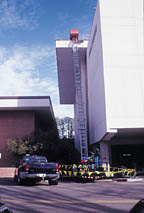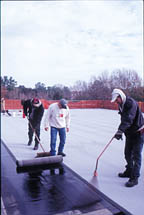Close Call at Talley Student Center



The Contractor
The successful bidder on the Talley Student Center re-roof was Ken Tetterton, vice president and general manager of Curtis Construction Company Inc., Kinston, N.C. Curtis Construction was founded in 1948 as a residential contractor by Robert Curtis. The company was incorporated in 1963 with son Robert (Bob) Curtis Jr. and E.L. Scott. With Curtis Jr. and Scott in charge, the firm moved into reroofing for the military until 1986 when Tetterton and a pair of investors purchased the company.With the new beginning in 1986, Tetterton moved the firm into other types of commercial and institutional jobs along with the military work. In addition to the commercial work, the firm also specializes in upper-end residential and historical roofing work. Tetterton traces his beginnings in the roofing industry back to 1981 when he went to work with a friend in the roofing business.
Curtis Construction currently employs roughly 100, and places about 60 percent of its work in the built-up and modified bitumen category. The balance of the company’s activities is split between single-ply commercial work, metal roofing and specialty roofing work. Like so many commercial roofing contractors, Curtis Construction was approached by consolidators, but did not “fit the profile” to become part of a roll-up.
The Specification
The contract for the re-roof of the Talley Student Center at NC State called for complete removal of 425 squares of the existing roof membrane and insulation system. The old system was to be replaced with a new 1/8-inch tapered roof insulation system and membrane covering, and furnished a 20-year “full value” warranty (no dollar limit type warranty) in 120 days.The building was sporting a gravel-surfaced built-up roof over a 2-inch layer of fiberglass insulation mopped to a concrete deck. The replacement system was furnished by Performance Roof Systems, and began with a torch-applied, smooth modified membrane, Bitutak, which served as a temporary roof and vapor barrier. Next came a 1/8-inch tapered polyiso insulation, Performance “CA” board, which is specifically designed for application by a polymer modified asphalt-based cold adhesive. The primary membrane consisted of a smooth base sheet installed over the insulation followed by a mineral-surfaced cap set in Permastic adhesive with welded laps.
The Permastic adhesive claims a high percentage of roofing grade solids and a low percentage of volatile organic compounds (VOCs). This product is on the leading edge of cold-application materials that directly address concerns over environmental and health issues, in addition to desirable performance characteristics. With the low-VOC content and tenacious adhesive qualities, torching the side and end laps completes the system in real time. The lack of a kettle or red labels on the adhesives helped to simplify this job. Unfortunately, other challenges presented themselves.
The Work
Everything sounds fairly straightforward so far, and it really was. Like many commercial re-roof jobs, this one did hold some unique “opportunities.” The first issue that had to be addressed was the limited access to the roof. The entire building was virtually surrounded by courtyards, enclosed alleyways and narrow streets. The building was occupied and in full use over the course of construction. The only space to stage the removal of the existing roofing and insulation, and to load the new materials, was an alley on one side of the building approximately 15 to 20 feet wide. Trucks had almost no room to load and unload. Tetterton made two basic decisions that took care of nearly all the headaches produced by these limitations.First, Tetterton called on A.G. Zalal of North American Bocker. Zalal has furnished all three of the NA Bocker telescopic elevators that Curtis Construction employs as a routine part of its work. The elevator used on this job was a gasoline powered, fully hydraulic unit extendable to 122 feet (this job only required about half of that). The elevator was fitted to take care of the removal of the old roofing as well as the lifting of all the replacement materials. The NA Bocker elevator is furnished with a wide variety of carriage devices to meet varying requirements. One of the most unique is the roof removal system that allows for placing trash in a hopper from inside the roof edge. Once the hopper is loaded with the waste roofing, it is lowered to a waiting container where it discharges automatically and is then sent back up for more.
The NA Bocker elevator was chosen for this job because of the height and especially because of its small footprint. The elevator was able to set up next to the building, requiring considerably less staging area than a crane. A roof-mounted hoist would have done the job of lifting the new materials, but would likely have been much more labor intensive if used to lower the trash. The need for separate trash chutes was eliminated, which was a good thing because there would not have been enough room for both a hoist and a trash chute on this job.
The second decision Tetterton made was to make the investment in spray-application equipment for the cold-applied modified bitumen roofing system. This was not Curtis Construction’s first cold-modified job, but was the inaugural job for full mechanization. Tetterton selected a trailer-mounted turnkey equipment package from Hennes-Johnson Equipment Co., Jordan, Minn. The unit consists of a spray wand, hose, hose reel, heating unit, generator and hydraulic spray-pump. This complete system has everything to spray-apply the adhesives for the insulation and modified membrane. A sophisticated electronic sensing and measuring device thermostatically controls the heating unit, which is LP gas fired. While this outfit will pump from 5-gallon cans or 55- gallon drums, reusable totes were used on this application. Full totes containing hundreds of gallons of mastic are shipped from the plant and returned there for refilling when empty. The savings in containers and handling more than make up for the additional shipping costs.
The decision to make the substantial investment in the spray equipment was fairly simple for Tetterton. To begin with, it is one of his firm’s guiding principals to invest in progressive equipment and systems as a way to maintain a competitive edge and to enhance profitability. In addition, Tetterton recognizes cold-applied modified roofing as the new trend in commercial roofing: “(It is) the wave of the future.”
When it came to the welding of the side laps, Tetterton drew the line at mechanizing, opting to stay with a hand-held LP gas torch instead of going with an electric robotic welder. According to job supervisor Jesse Ibarra, they have tried the robots and simply feel the job can be done as quickly and safely with a well-trained technician wielding a torch.
In addition to the challenges of staging this job, there were several other “hiccups” that had to be dealt with. The first one came along when the fire marshal wanted to stop the spray operation because it had not been registered as a “kettle.” Well, it isn’t a kettle, but it does heat bitumen to 275 degrees. The solution only involved reordering the placement of the fire extinguisher and some of the warning tape. This provided a lesson as well, since the crew now treats the spray outfit with the same rules as a kettle.
The transition from squeegees to a fully operational hydraulic spray outfit was not without some difficulty. The level of training required was a bit higher than anticipated. While Tetterton indicated the start-up orientation was weak, the company received excellent back-up from the factory on any issues experienced with the new equipment. The day we visited the job, temperatures were at the low end of the scale for normal operations, and the unit performed well.
There were some tense moments during tear-off, as the old roof held water after a rain. And then there was that time the wind came up rather suddenly and took a piece of insulation into a single-dome skylight. Fortunately for all, the incidents were no more than a bother, and the job came in well within the allotted time.
We were impressed with the cleanliness of the site and the work that had been completed to that point. The laps were tucked and tight, everything had its place, and all the lines were remarkably straight and even. Tetterton credited the system and equipment to some extent, but mainly to Ibarra and his crew. He credits their tremendous work ethic and determination to run a clean, safe shop. Jose Chavez was the foreman, and Jaime Ibarra was the lead man on this job.
The Future
Ken Tetterton has a clear vision for the future of Curtis Construction Co.: Grow the business by staying on the cutting edge. For example, Chad Herring, who will soon graduate from the construction management program at East Carolina, joined us on the job. Herring is slated to join the firm to become an estimator and project manager after graduation. Tetterton sees the addition of a young man fresh out of college as a win-win situation, as he will bring a depth of knowledge in computer-aided design that the firm does not currently posses. Keeping up with the latest in roofing systems and equipment, as well as the latest in design and estimating technology are all seen as important elements to the future of the company.Tetterton sees the key challenge of 2001 as “Maintaining the profit margins we’ve been used to over the last five years.” And as for success, his philosophy is simple, “Doing a good job.” Not just roofing, but in everything you do, complete it “as well as you absolutely can.” And so it was with the reroof of the Talley Student Center.
Looking for a reprint of this article?
From high-res PDFs to custom plaques, order your copy today!



